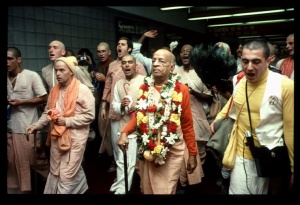CC Madhya 19.189 (1975): Difference between revisions
(Vanibot #0027: CCMirror - Mirror CC's 1996 edition to form a basis for 1975) |
(Vanibot #0020: VersionCompareLinker - added a link to the Version Compare feature) |
||
| Line 2: | Line 2: | ||
<div style="float:left">'''[[Sri Caitanya-caritamrta (1975)|Śrī Caitanya-caritāmṛta (1975)]] - [[CC Madhya (1975)|Madhya-līlā]] - [[CC Madhya 19 (1975)|Chapter 19: Lord Śrī Caitanya Mahāprabhu Instructs Śrīla Rūpa Gosvāmī]]'''</div> | <div style="float:left">'''[[Sri Caitanya-caritamrta (1975)|Śrī Caitanya-caritāmṛta (1975)]] - [[CC Madhya (1975)|Madhya-līlā]] - [[CC Madhya 19 (1975)|Chapter 19: Lord Śrī Caitanya Mahāprabhu Instructs Śrīla Rūpa Gosvāmī]]'''</div> | ||
<div style="float:right">[[File:Go-previous.png|link=CC Madhya 19.188 (1975)|Madhya-līlā 19.188]] '''[[CC Madhya 19.188 (1975)|Madhya-līlā 19.188]] - [[CC Madhya 19.190 (1975)|Madhya-līlā 19.190]]''' [[File:Go-next.png|link=CC Madhya 19.190 (1975)|Madhya-līlā 19.190]]</div> | <div style="float:right">[[File:Go-previous.png|link=CC Madhya 19.188 (1975)|Madhya-līlā 19.188]] '''[[CC Madhya 19.188 (1975)|Madhya-līlā 19.188]] - [[CC Madhya 19.190 (1975)|Madhya-līlā 19.190]]''' [[File:Go-next.png|link=CC Madhya 19.190 (1975)|Madhya-līlā 19.190]]</div> | ||
{{CompareVersions|CC|Madhya 19.189|CC 1975|CC 1996}} | |||
{{RandomImage}} | {{RandomImage}} | ||
==== TEXT 189 ==== | ==== TEXT 189 ==== | ||
<div class="verse"> | <div class="verse"> | ||
:śānta- | :śānta-bhakta--nava-yogendra, sanakādi āra | ||
:dāsya-bhāva- | :dāsya-bhāva-bhakta--sarvatra sevaka apāra | ||
</div> | </div> | ||
| Line 25: | Line 24: | ||
<div class="translation"> | <div class="translation"> | ||
"Examples of śānta-bhaktas are the nine Yogendras and the four Kumāras. Examples of devotees in dāsya-bhakti are innumerable, for such devotees exist everywhere. | |||
</div> | </div> | ||
| Line 32: | Line 31: | ||
<div class="purport"> | <div class="purport"> | ||
The nine Yogendras are Kavi, Havi, Antarīkṣa, Prabuddha, Pippalāyana, Āvirhotra, Draviḍa (Drumila), Camasa and Karabhājana. The four Kumāras are Sanaka, Sanandana, Sanat-kumāra and Sanātana. The servant devotees in Gokula are Raktaka, Citraka, Patraka and so on. In Dvārakā there are servants like Dāruka, and in the | The nine Yogendras are Kavi, Havi, Antarīkṣa, Prabuddha, Pippalāyana, Āvirhotra, Draviḍa (Drumila), Camasa and Karabhājana. The four Kumāras are Sanaka, Sanandana, Sanat-kumāra and Sanātana. The servant devotees in Gokula are Raktaka, Citraka, Patraka and so on. In Dvārakā there are servants like Dāruka, and in the Lord's pastimes in the material world there are servants like Hanumān. | ||
</div> | </div> | ||
Latest revision as of 11:53, 27 January 2020

A.C. Bhaktivedanta Swami Prabhupada
TEXT 189
- śānta-bhakta--nava-yogendra, sanakādi āra
- dāsya-bhāva-bhakta--sarvatra sevaka apāra
SYNONYMS
śānta-bhakta—the neutral devotees; nava—nine; yogendra—saintly persons; sanaka-ādi āra—and the four Kumāras, headed by Sanaka; dāsya-bhāva-bhakta—devotees in dāsya-rasa; sarvatra sevaka apāra—similar innumerable servants everywhere.
TRANSLATION
"Examples of śānta-bhaktas are the nine Yogendras and the four Kumāras. Examples of devotees in dāsya-bhakti are innumerable, for such devotees exist everywhere.
PURPORT
The nine Yogendras are Kavi, Havi, Antarīkṣa, Prabuddha, Pippalāyana, Āvirhotra, Draviḍa (Drumila), Camasa and Karabhājana. The four Kumāras are Sanaka, Sanandana, Sanat-kumāra and Sanātana. The servant devotees in Gokula are Raktaka, Citraka, Patraka and so on. In Dvārakā there are servants like Dāruka, and in the Lord's pastimes in the material world there are servants like Hanumān.